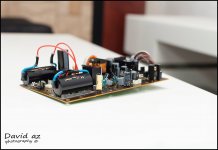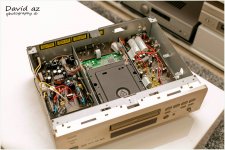Cap quality is not the issue. It is cap design intent. X2 caps are designed to be failsafe - overvoltage causing local arcing does not cause a short but merely removes a small part of the electrode so you get a gradual decline in cap value. This is essential for a cap across the mains, but merely useful for a cap across the secondary.22mannightstar said:I couldn't see why it would make any difference as to cap quality because AC noise is AC noise but I see now.
I am unclear what you mean by "AC noise". If incoming noise is a problem then you need a filter, not just a cap. X2 cap across the primary reduces switch arcing. A cap across the secondary can reduce ringing caused by rectifier commutation.
In the Western hemisphere you can get 1200 VDC on the AC mains line due to refrigerator/AC compressor turn off. I was a test line specialist, our overload tester would make a spike that big with every unit, every 15 seconds. I had a tek 470 memory scope to look at it with at work. About the same size spike IMHO comes from lighting surge, damped down to that voltage by any refrigerators/blowers on the line at the time. "250 VAC" rated x2 caps have that "normal" surge voltage built into the rating. Designers used to use 1000 VDC rated ceramic caps before X2 was invented. I've had lighting blow a 1000 v ceramic turn off pop cap to dust, and arc across the slide power switch of a dynaco PAS2 preamp. Came home from work on a stormy day and the preamp was on with the slide in the off position, and only the lead was left of the turn off pop cap.You don't need an X2 cap on the secondary side, as failure here has less catastrophic consequences than a short across the mains. Just pick a cap with DC rating about twice the peak AC voltage.
I disagree with Andrew T's statement after that one, also, 1200 spike into a 2:1 65-0-65 transformer can produce 600 v spike on the secondary.
Personally I put a salvage 300-500 v rated MOS supressor across the primary these days after the fuse. (these are blue with a voltage rating and an S with a slash through it). Then I put a ceramic 0.1 600-1000v cap across the bridge rectifier, extending the leads to fit with little hooks in the wires. This cuts stress on the filter caps, IMHO with a cap that is designed to supress this spike, even though it is halved by the power transformer. Putting it on the bridge rectifier keeps 65 VAc off my single project board, the one that I poke around on with probes which sometimes slip and bridge conductors. Dynaco put the .1 ceramic cap on the ST120 PC14 power regulator board, which I've eliminated since it collapses into regulation mode if you put a 100 w light bulb in series with the AC line for test. Good practice before MOS supressors were invented about 1978?
All these spike filtration parts can be salvaged from dead PCAT power supplies from obsolete dead computers from your use or the charity resale store. A dead computer is about the price of the freight of one box from an electronics distributor 2 states away. The case makes a convenient TV drinks stand, or can be sawed up to make amp load resistor stands to keep the logs up in the air.
Cinch 53 terminal strips make elegant mounts for the MOS supressor near the power switch.
Last edited:
I guess when you say "1200V DC" you mean "1200V spike"? Such spikes are possible, but I would expect them to be rare. The mains transformer will attenuate them, as it is not designed to have a wide frequency response. The rectifiers plus reservoir cap will help to clamp them.
This remark is not directly related to the contents of this discussion, but I think It's worth mentioning it: too much info does rarely do harm.
X or Y caps are pretty poor in their main role: suppression.
Their safety characteristics mean their metallization is rather shallow, which translates into high ESR, and thus poor clamping of high voltage pulses.
OK, the built-in resistance has useful damping properties, but in the end, the ability to clamp a high energy pulse from a low impedance source is related to the esr, which is rather high.
As a consequence, never try to use a PP X-cap in a resonant circuit where it has to withstand a high reactive power.
In PFC supplies, the X-cap is protected by some series impedance (inductance?), and the brunt of the switching is taken care of by a (non X-rated) PP or similar, which is certainly problematic, because it is subjected to exactly the same stresses (from a regulatory POV)as the regular X cap
X or Y caps are pretty poor in their main role: suppression.
Their safety characteristics mean their metallization is rather shallow, which translates into high ESR, and thus poor clamping of high voltage pulses.
OK, the built-in resistance has useful damping properties, but in the end, the ability to clamp a high energy pulse from a low impedance source is related to the esr, which is rather high.
As a consequence, never try to use a PP X-cap in a resonant circuit where it has to withstand a high reactive power.
In PFC supplies, the X-cap is protected by some series impedance (inductance?), and the brunt of the switching is taken care of by a (non X-rated) PP or similar, which is certainly problematic, because it is subjected to exactly the same stresses (from a regulatory POV)as the regular X cap
Every refrigerator we shipped prior to 1993? would produce one of these 1200v spikes every time it shut off with the AC voltage high. I imagine air conditioners with even bigger compressors produce worse. The point is if the power transformer doesn't supress this, the bridge rectifier has to. So 600 V rated bridge rectifiers in all cases of amps with 2:1 transfomers? For western hemisphere service and a reliable rectifier Install a MOS surge supressor before the transformer, and or a .01 uf 1000 vdc ceramic cap after.I guess when you say "1200V DC" you mean "1200V spike"? Such spikes are possible, but I would expect them to be rare. The mains transformer will attenuate them, as it is not designed to have a wide frequency response. The rectifiers plus reservoir cap will help to clamp them.
Expecting the transformer to supress lightning surges which are even higher in energy than motor shutoff is like putting a rug over the rattlesnake and pretending it isn't there. Of course, I live in lightning storm central here in the midwest USA. Those in the UK may brag about their storms, but we laugh at you over here. After every spring there are a collection of dead appliances on the curb for garbage pickup, victims of planned obsolescence (and no surge supression) by the manufacturers. Receivers and televisions, included. $30000 digital organs are not immune to surge damage, see organforum church & classic organs thread. Few are protected, and some are trashed annually.
I'm working over a 1987 switcher power supply from a famous digital organ brand this weekend. There is less surge protection built in that $1800 part than a lowly PCAT ATX power supply. However, the original engineering on the PCAT was done by IBM, and the ****ese copiers haven't left the useful parts out yet.
I'll tell you what suppliers take their surge supression seriously. VFD motor drive manufacturers, the surviving ones, have more serious suppression stages than a PCAT ATX supply. Allen Bradley, TB Woods, Yakasaka, Omron drives have serious 22 mm dia MOS supressors in their first stages. These are all switcher or SCR supplies with a rectifier capacitor mains stage front end. PCAT only has 7 mm surge supressors.
Last edited:
Air conditioners are rare in UK houses. We all have fridges, of course, but our audio equipment seems to survive OK. Maybe the fact that our mains is twice the voltage of yours gives us an extra factor of two in safety margin? And our appliances draw half the current so have less stored energy? Maybe our mains supply is cleaner?
As far as I recall, over the last 45 years I have only once had to replace a rectifier diode (in a TV set). I have replaced two X2 caps used as droppers: in a doorbell, and an oven timer. The latter shows we have spikes, but rarely enough to damage equipment.
As far as I recall, over the last 45 years I have only once had to replace a rectifier diode (in a TV set). I have replaced two X2 caps used as droppers: in a doorbell, and an oven timer. The latter shows we have spikes, but rarely enough to damage equipment.
I have stripped out a few X2 and Y2 caps from redundant equipment.
I measured the capacitance of these old used capacitors.
All had less than the rated capacitance, some as low as 60%.
I suspect this is an indication of these self healing capacitors losing some of their metalization due to interference spikes on our UK mains.
They did not fail, but they gradually use up their plates.
I measured the capacitance of these old used capacitors.
All had less than the rated capacitance, some as low as 60%.
I suspect this is an indication of these self healing capacitors losing some of their metalization due to interference spikes on our UK mains.
They did not fail, but they gradually use up their plates.
That is why I had to change them: their falling capacitance meant they were no longer properly powering the circuit fed from them.
PS I saved about £60 by changing an X2 cap in the oven timer instead of buying a new timer board. The symptom was that the VFD display was dim, but it turned out that the display was fine once it was given the correct voltages again.
PS I saved about £60 by changing an X2 cap in the oven timer instead of buying a new timer board. The symptom was that the VFD display was dim, but it turned out that the display was fine once it was given the correct voltages again.
Last edited:
- Status
- Not open for further replies.
- Home
- Design & Build
- Parts
- X2 caps

